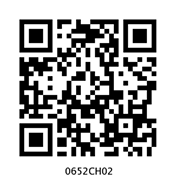Table of Contents
2
Components of Food
In Chapter 1, we made lists of the food items that we eat. We also identified food items eaten in different parts of India and marked these on its map.
A meal could consist of chapati, dal and brinjal curry. Another may be rice, sambar and a vegetable preparation of lady’s finger (bhindi). Yet another meal could be appam, fish curry and vegetables.
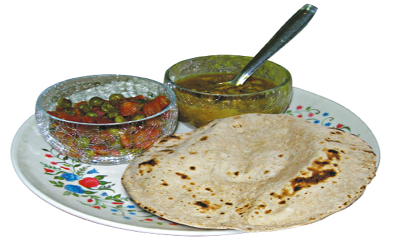
Activity 1
Our meals usually have at least one item made of some kind of grain. Other items could be a dal or a dish of meat and vegetables. It may also include items like curd, butter milk and pickles. Some examples of meals from different regions are given in Table 2.1. Select food items you depicted on the map in Chapter 1. Add some more meals to this list and enter these in Table 2.1.
Table 2.1 Some common meals of different regions/states

Sometimes, we may not really have all this variety in our meals. If we are travelling, we may eat whatever is available on the way. It may not be possible for some of us, to eat such a variety of items, most of the time.
There must be some reason though, why meals usually consist of such a distribution. Do you think that our body needs different kinds of food for some special purpose?
2.1 What Do Different Food Items Contain?
We know that each dish is usually made up of one or more ingredients, which we get from plants or animals. These ingredients contain some components that are needed by our body. These components are called nutrients. The major nutrients in our food are named carbohydrates, proteins, fats, vitamins and minerals. In addition, food contains dietary fibres and water which are also needed by our body.
Do all foods contain all these nutrients? With some simple methods we can test whether cooked food or a raw ingredient contains one or more of these nutrients. The tests for presence of carbohydrates, proteins and fats are simpler to do as compared to the tests for other nutrients. Let us do these tests and record all our observations in Table 2.2.
For carrying out these tests, you will need solutions of iodine, copper sulphate and caustic soda. You will also need a few test tubes and a dropper.
Try these tests on cooked food items as well as raw materials. Table 2.2 shows you a way to record the observations from these tests. Some food items are given in this table. You can conduct the tests either with these or any other available food items. Do these tests carefully and do not try to eat or taste any chemicals.
If the required solutions are not available in readymade form, your teacher can prepare them as given in the box.
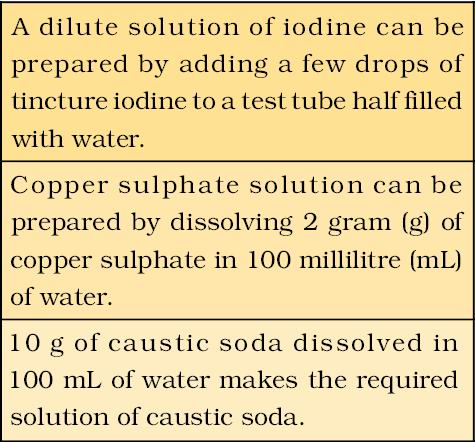
Let us begin by testing different food items to see if they contain carbohydrates. There are many types of carbohydrates. The main carbohydrates found in our food are in the form of starch and sugars. We can easily test if a food item contains starch.
Activity 2
Test for Starch
Take a small quantity of a food item or a raw ingredient. Put 2-3 drops of dilute iodine solution on it (Fig. 2.1). Observe if there is any change in the colour of the food item. Did it turn blue-black?
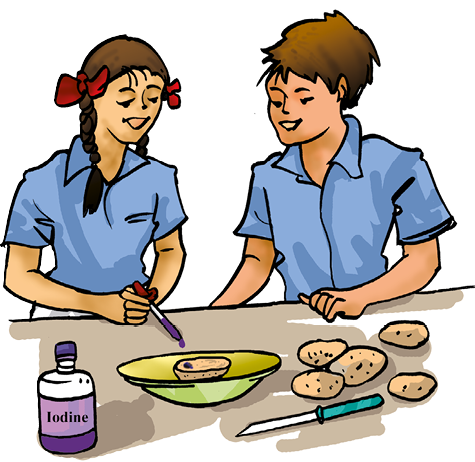
Fig. 2.1 Testing for starch
A blue-black colour indicates that it contains starch.Test for Protein
Take a small quantity of a food item for testing. If the food you want to test is a solid, you first need to make a paste of it or powder it. Grind or mash a small quantity of the food item. Put some of this in a clean test tube, add 10 drops of water to it and shake the test tube.
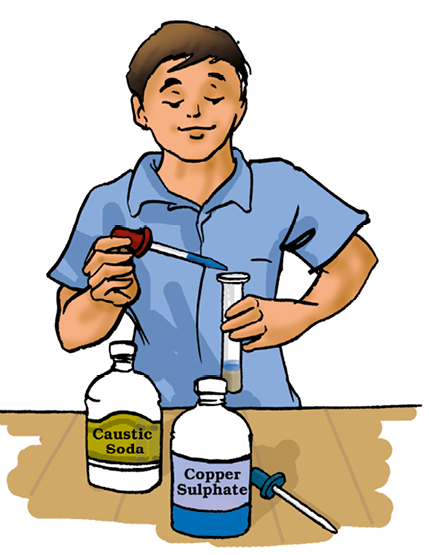
Fig. 2.2 Testing for protein
Now, using a dropper, add two drops of solution of copper sulphate and ten drops of solution of caustic soda to the test tube (Fig. 2.2). Shake well and let the test tube stand for a few minutes. What do you see? Did the contents of the test tube turn violet? A violet colour indicates presence of proteins in the food item.
Now, you can repeat this test on other food items.
Table 2.2 Nutrients present in some food items
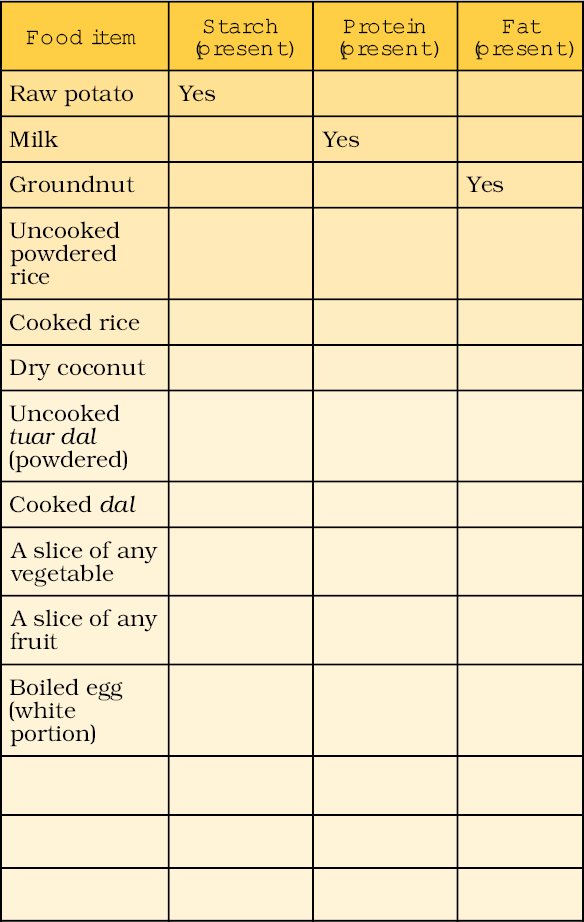
Test for Fats
Take a small quantity of a food item. Wrap it in a piece of paper and crush it. Take care that the paper does not tear. Now, straighten the paper and observe it carefully. Does it have an oily patch? Hold the paper against light. Are you able to see the light faintly, through this patch?
An oily patch on paper shows that the food item contains fat. The food items may sometimes contain a little water. Therefore, after you have rubbed an item on paper, let the paper dry for a while. If there were any water that may have come from food, it would dry up after some time. If no oily patch shows up after this, the food item does not contain any fat.
What do these tests show? Are fats, proteins and starch present in all the food items that you tested? Does a food item contain more than one nutrient? Do you find any food item that does not contain any of these nutrients?
We tested food items for three nutrients — carbohydrates, proteins and fats. There are also other nutrients like vitamins and minerals that are present in different food items. Why do we need all these nutrients?
2.2 What do Various Nutrients do for our Body?
Carbohydrates mainly provide energy to our body. Fats also give us energy. In fact, fats give much more energy as compared to the same amount of carbohydrates. Foods containing fats and carbohydrates are also called ‘energy giving foods’ (Fig. 2.3 and Fig. 2.4).

Fig. 2.3 Some sources of carbohydrates

Fig. 2.4 Some sources of fats: (a) plant sources and (b) animal sources
Proteins are needed for the growth and repair of our body. Foods proteins are often called ‘body building foods’ (Fig 2.5).

Fig. 2.5 Some sources of proteins: (a) plant sources and (b) animal sources
Vitamins help in protecting our body against diseases. Vitamins also help in keeping our eyes, bones, teeth and gums healthy.
Vitamins are of different kinds known by different names. Some of these are Vitamin A, Vitamin C, Vitamin D, Vitamin E and K. There is also a group of vitamins called Vitamin B-complex. Our body needs all types of vitamins in small quantities. Vitamin A keeps our skin and eyes healthy. Vitamin C helps body to fight against many diseases. Vitamin D helps our body to use calcium for bones and teeth. Foods that are rich in different vitamins are shown in Fig. 2.6 to Fig. 2.9.

Fig. 2.7 Some sources of Vitamin B

Fig. 2.8 Some sources of Vitamin C

Fig. 2.9 Some sources of Vitamin D
Minerals are needed by our body in small amounts. Each one is essential for proper growth of body and to maintain good health. Some sources of different minerals are shown in Fig. 2.10.

Most food items, usually, have more than one nutrient. You may have noticed this, while recording your observations in Table 2.2. However, in a given raw material, one particular nutrient may be present in much larger quantity than in others. For example, rice has more carbohydrates than other nutrients. Thus, we say that rice is a “carbohydrate rich” source of food.
Besides these nutrients, our body needs dietary fibres and water. Dietary fibres are also known as roughage. Roughage is mainly provided by plant products in our foods. Whole grains and pulses, potatoes, fresh fruits and vegetables are main sources of roughage. Roughage does not provide any nutrient to our body, but is an essential component of our food and adds to its bulk. This helps our body get rid of undigested food.

Fig. 2.10 Sources of some minerals
Water helps our body to absorb nutrients from food. It also helps in throwing out some wastes from body as urine and sweat. Normally, we get most of the water that our body needs from the liquids we drink — such as water, milk and tea. In addition, we add water to most cooked foods. Let’s see if there is any other source which provides water to our body.
Activity 3
Take a tomato or a fruit like lemon. Cut it into small pieces. Do your hands get wet while doing so?
Carefully observe whenever vegetables and fruits are being cut, peeled, grated or mashed at your home. Do you find any fresh vegetables or fruits that do not contain some amount of water?
We see that many food materials themselves contain water. To some extent, our body needs are met by this water. Apart from this, we also add water while cooking many food items.
2.3 Balanced Diet
The food we normally eat in a day is our diet. For growth and maintenance of good health, our diet should have all the nutrients that our body needs, in right quantities. Not too much of one and not too little of the other. The diet should also contain a good amount of roughage and water. Such a diet is called a balanced diet.
Do you think that people of all ages need the same type of diet? Do you also think that, what we need for a balanced diet would depend on the amount of physical work that we do?
Prepare a chart of whatever you eat over a period of a week. Check whether all the nutrients mentioned are present in one or the other food items being eaten within a day or so.
Pulses, groundnut, soyabean, sprouted seeds (moong and Bengal gram), fermented foods (South Indian foods such as idlis), a combination of flours (missi roti, thepla made from cereals and pulses), banana, spinach, sattu, jaggery, available vegetables and other such foods provide many nutrients. Therefore, one can eat a balanced diet without expensive food materials.
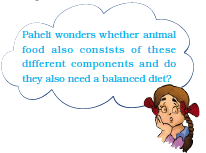
Eating the right kind of food is not enough. It should also be cooked properly so that its nutrients are not lost. Are you aware that some nutrients get lost in the process of cooking and preparations?
If the vegetables and fruits are washed after cutting or peeling them, it may result in the loss of some vitamins. The skins of many vegetables and fruits contain vitamins and minerals. Similarly, repeated washing of rice and pulses may remove some vitamins and minerals present in them.
We all know that cooking improves the taste of food and makes it easier to digest. At the same time, cooking also results in the loss of certain nutrients. Many useful proteins and considerable amounts of minerals are lost if excess water is used during cooking and is then thrown away.
Vitamin C gets easily destroyed by heat during cooking. Would it not be sensible to include some fruits and raw vegetables in our diet?
Boojho thought that fats would be the best foods to eat, all the time. A katori (bowl) of fat will give much more energy than a katori of carbohydrate rich food, isn’t it? So, he ate nothing but food rich in fats — fried food like samosa and poori (snacks), malai, rabdi and peda (sweets).
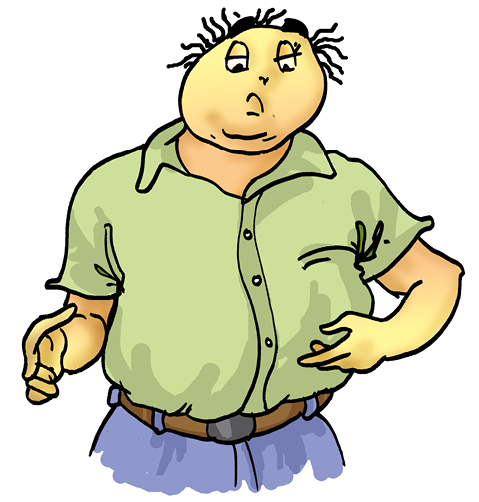
Do you think he was right? No, of course not! It can be very harmful for us to eat too much of fat rich foods and we may end up suffering from a condition called obesity.
2.4 Deficiency Diseases
A person may be getting enough food to eat, but sometimes the food may not contain a particular nutrient. If this continues over a long period of time, the person may suffer from its deficiency. Deficiency of one or more nutrients can cause diseases or disorders in our body. Diseases that occur due to lack of nutrients over a long period are called deficiency diseases.
If a person does not get enough proteins in his/her food for a long time, he/she is likely to have stunted growth, swelling of face, discolouration of hair, skin diseases and diarrhoea.
If the diet is deficient in both carbohydrates and proteins for a long period of time, the growth may stop completely. Such a person becomes very lean and thin and so weak that he/she may not even be able to move.
Deficiency of different vitamins and minerals may also result in certain diseases or disorders. Some of these are mentioned in Table 2.3.
All deficiency diseases can be prevented by taking a balanced diet.
In this chapter, we asked ourselves the reason why widely varying food from different regions had a common distribution. This distribution, we find, ensures that our meals have a balance of the different nutrients needed by the body.
Table 2.3 – Some diseases/disorders caused by deficiency of vitamins and minerals
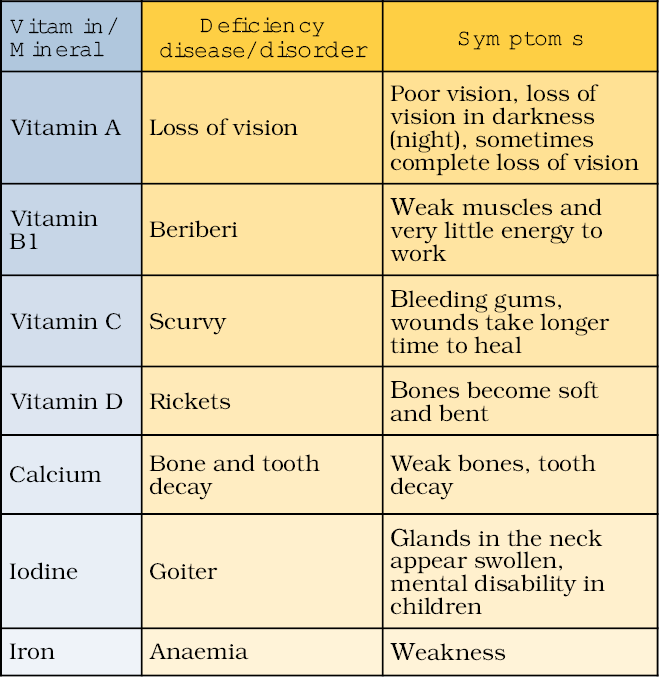
KeyWords
Balanced diet
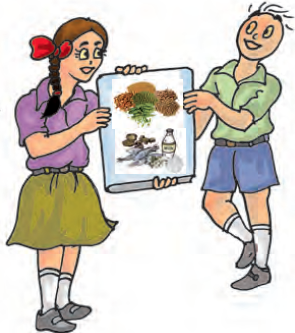
Beriberi
Carbohydrates
Energy
Fats
Minerals
Nutrients
Proteins
Roughage
Scurvy
Starch
Vitamins
Summary
• The major nutrients in our food are carbohydrates, proteins, fats, vitamins and minerals. In addition, food also contains dietary fibres and water.
• Carbohydrates and fats mainly provide energy to our body.
• Proteins and minerals are needed for the growth and the maintenance of our body.
• Vitamins help in protecting our body against diseases.
• Balanced diet provides all the nutrients that our body needs, in right quantities, along with adequate amount of roughage and water.
• Deficiency of one or more nutrients in our food for a long time may cause certain diseases or disorders.
EXERCISE
1. Name the major nutrients in our food.
2. Name the following:
(a) The nutrients which mainly give energy to our body.
(b) The nutrients that are needed for the growth and maintenance of our body.
(c) A vitamin required for maintaining good eyesight.
(d) A mineral that is required for keeping our bones healthy.
3. Name two foods each rich in:
(a) Fats
(b) Starch
(c) Dietary fibre
(d) Protein
4. Tick (√) the statements that are correct.
(a) By eating rice alone, we can fulfill nutritional requirement of our body. ( )
(b) Deficiency diseases can be prevented by eating a balanced diet. ( )
(c) Balanced diet for the body should contain a variety of food items. ( )
(d) Meat alone is sufficient to provide all nutrients to the body. ( )
5. Fill in the blanks.
(a) ______________ is caused by deficiency of Vitamin D.
(b) Deficiency of ______________ causes a disease known as beri-beri.
(c) Deficiency of Vitamin C causes a disease known as ______________.
(d) Night blindness is caused due to deficiency of ____________ in our food.
SUGGESTED PROJECTS AND ACTIVITIES
1. Prepare a diet chart to provide balance diet to a twelve year old child. The diet chart should include food items which are not expensive and are commonly available in your area.
2. We have learnt that excess intake of fats is harmful for the body. What about other nutrients? Would it be harmful for the body to take too much of proteins or vitamins in the diet? Read about diet related problems to find answers to these questions and have a class discussion on this topic.
3. Test the food usually eaten by cattle or a pet to find out which nutrients are present in animal food. Compare results obtained from the whole class to conclude about balanced diet requirements for different animals.
